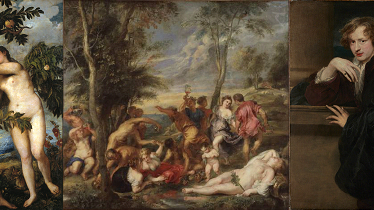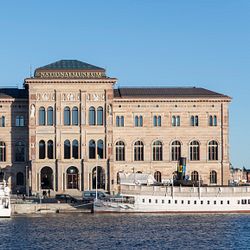
Pressmeddelande -
Leading Baroque masters together at Nationalmuseum
On Thursday 25 February, the Rubens & van Dyck exhibition opens at Nationalmuseum in Stockholm. From then until 23 May, visitors will be able to see works by two of the 17th century’s leading painters and some of their disciples.
The exhibition brings together works by Peter Paul Rubens and Anthonis van Dyck, two of the leading painters of the 17th-century Baroque, highlighting the relationship between them and their unparalleled influence on Flemish painting in their day. In all, 123 works will be on show – a mix of portraits, landscapes, historic scenes, kitchen still lifes and hunting scenes. Works from Nationalmuseum’s own fine Flemish art collection will appear alongside works on loan from other museums and collections.
Rubens often used mythological and historical motifs. He was inspired by Titian, the Italian Renaissance master, and painted free copies of several Titian works. Both masters’ versions of Adam and Eve will appear side by side in the exhibition. Van Dyck collaborated extensively with Rubens in the early stages of his career but soon became a master in his own right with his own distinct style. Best known for his portraiture, he painted many religious works as well. The exhibition also features historic scenes by Jacob Jordaens, kitchen still lifes by Adriaen van Utrecht, and dramatic hunting scenes by Frans Snyders, Paul de Vos and Jan Fyt.
Nationalmuseum is publishing a detailed catalogue in Swedish with a summary in English, containing images and descriptions of all the works in the exhibition.
The Rubens & van Dyck exhibition runs from 25 February to 23 May 2010.
Further information
Görel Cavalli-Björkman, exhibition curator: gcb@nationalmuseum.se, +46 70 811 8920.
Hanna Tottmar, information officer: htr@nationalmuseum.se, +46 8 5195 4390/4391.
Media images
www.nationalmuseum.se/press
Background
The exhibition focuses on the huge success enjoyed by Flemish painters in the 17th century. A distinctive style, featuring vivid and colourful motifs, appeared in portraits, landscapes, hunting scenes and still lifes. Art trading flourished, and paintings were exported to all parts of Europe. As a result of this high demand, artists chose to specialize, and close working relationships developed. Rubens, for instance, collaborated with Jan Brueghel, Frans Snyders and Anthonis van Dyck on various details in his paintings.
Many Flemish works reached Sweden in the 17th century as a result of close trading links. Queen Kristina was very interested in Flemish art, and in the 18th century Carl Gustaf Tessin purchased works for the Swedish royal collection. Many influential families from the Netherlands emigrated to Sweden to escape religious persecution, bringing their art collections with them. A number of the works that arrived in Sweden in the 17th and 18th centuries are now part of Nationalmuseum’s collection.
Lectures
Friday 26 February, 2 pm: Christopher Brown, director of the Ashmolean Museum, Oxford, on the young Anthonis van Dyck. Venue: Auditorium, Nationalmuseum.
Sunday 21 March, 1–3 pm: Rubens and van Dyck theme day in the Auditorium at Nationalmuseum. Görel Cavalli-Björkman, exhibition curator, on Rubens’ relationship to Titian. Karin Sidén, head of research, on van Dyck and portraiture in 17th-century Flanders.
Photos
Titian, Adam and Eve. © Museo Nacionál del Prado, Madrid.
Peter Paul Rubens, The Andrians. © Nationalmuseum.
Anthonis van Dyck, Self-portrait. © The Metropolitan Museum of Art.
